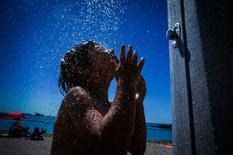- Homepage
- Social Affairs and Health
- News
- How to protect your child from the sun and hot weather
How to protect your child from the sun and hot weather
Children are particularly vulnerable to heat-related illnesses (dehydration, hyperthermia, heatstroke). It is therefore essential to prevent, recognise and treat these illnesses during the summer months.
Children under 12 months should not be exposed to the sun
Children should not be exposed to the sun between 12 p.m. and 4 p.m. Prolonged exposure to the sun or to a very hot environment increases the risk of sunstroke or heat exhaustion. Generally speaking, make sure you limit the length of exposure.
Regardless of the time or place of exposure, protect children from the heat by ensuring that they are wearing a t-shirt, a hat and sunglasses. Sun cream (SPF 50) should be applied to all parts of the body that are not covered by clothes (face and body) and are exposed to the sun. Apply every two hours and after swimming.
This dual protection, combined with regular hydration, is the best tool against ultraviolet rays.
Drink regularly to prevent dehydration
It is recommended that children are regularly given something to drink, even if they are not asking for anything.
Children become dehydrated when they lose more liquid through sweating or urinating than they consume.
Children aged under 6 months can lose water extremely quickly. Remember that an infant’s body contains a lot of water, and is therefore highly vulnerable: “Water makes up 75–80% of a newborn’s body weight, and 65% of the weight of a child over 12 months.”
In addition, dehydration increases the risk of heat-related illness.
Unusual weight loss, less frequent urination and darker urine can be signs of dehydration.
Hot weather causes easily detected symptoms
Symptoms, which may be multiple or limited to just a few, can be quickly detected in children:
- high fever: internal temperature which can reach more than 40 degrees;
- dry mouth;
- rapid pulse;
- unusual drowsiness;
- hyperexcitability;
- hollow eyes and dilated pupils;
- nausea and vomiting;
- loss of consciousness.
If you observe these symptoms, move your child into the shade, undress them and cool them down. Give them a drink and dampen their skin.
It is important to take action quickly, since heatstroke, when left untreated, can lead to fainting and have serious consequences. If symptoms are severe and the situation is ongoing for any length of time, call 18 (or 112).
Critical temperatures in cars
Even when it is relatively cool (15–20°C) outside, the temperature inside a vehicle can climb above 45°C. This can happen extremely quickly, with rises of around 10°C occurring in just 10 minutes.
Children should therefore never be left alone in a car parked in direct sunlight.
When travelling by car during hot weather, make sure that your child is dressed in loose, light-coloured, cotton clothing. Ensure that they drink regularly and cool them down often, using a facial mister, for example.
Autres actualités du thème

Participation de Christophe ROBINO à la 10e réunion de haut niveau de l’Initiative des petits pays de l’OMS Europe à Limassol du 10 au 12 avril 2024










